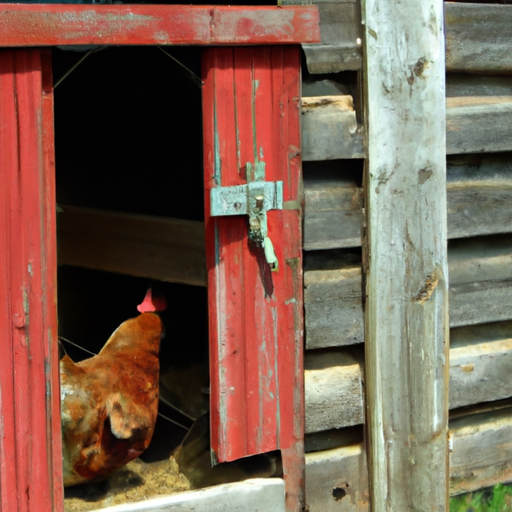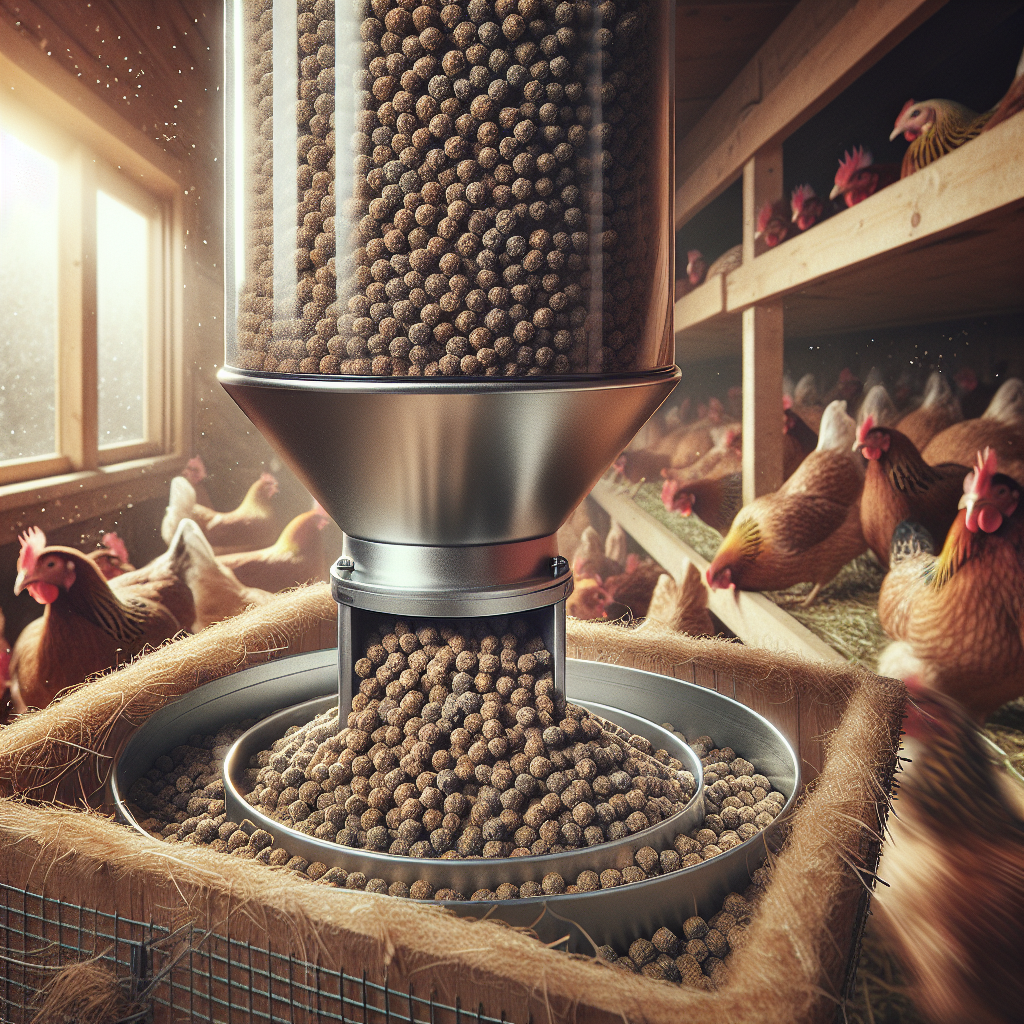If you’ve ever dreamt of having your own backyard chickens but hesitated because you’re a beginner with little to no carpentry skills, fret not! The answer to your dilemma lies in DIY chicken coop designs that are specifically tailored for beginners. Whether you’re a novice or just looking for a hassle-free option, these easy-to-implement designs will guide you through the process of building a chicken coop without overwhelming you. With the right resources and a little bit of determination, you’ll be well on your way to creating a cozy home for your feathered friends in no time.
The Importance of Having a Well-Designed Chicken Coop
Having a well-designed chicken coop is essential for ensuring the safety and well-being of your chickens. A good coop not only protects them from predators and other threats but also provides them with adequate space and comfort. Additionally, a well-designed coop promotes good health and hygiene practices, making it easier to maintain a clean and healthy living environment for your feathered friends.
Ensuring the Safety and Well-being of Your Chickens
One of the primary functions of a chicken coop is to provide a safe and secure environment for your chickens. A well-designed coop helps keep them protected from predators like foxes, raccoons, and even neighborhood dogs. By providing a sturdy structure and implementing predator protection measures, such as sturdy fencing and lockable doors, you can significantly reduce the risk of harm to your chickens.
Another important aspect of ensuring the well-being of your chickens is providing them with a comfortable living space. A well-designed coop should have ample space for your chickens to move around and stretch their wings. It should also include features such as perches and nesting boxes to meet their natural behaviors and needs.
Preventing Predators and Other Threats
Predators pose a significant threat to backyard chicken flocks. A poorly designed coop can make it easy for predators to access your chickens and cause harm. Therefore, it is crucial to consider predator-proofing measures when designing your coop.
Some effective predator prevention strategies include installing secure fencing around the coop, using hardware cloth to cover windows and vents, and reinforcing doors and entry points. By incorporating these features into your coop design, you can provide a safe haven for your chickens and minimize the risk of any unwanted visitors.
Providing Adequate Space and Comfort
Chickens, like any other living creatures, require adequate space to live comfortably. Overcrowding can lead to stress, aggression, and health issues among your flock. When designing your chicken coop, it is important to consider the number of chickens you plan to keep and how much space they will need.
A general rule of thumb is to provide at least 4 square feet of coop space per chicken. In addition to the floor space, consider providing roosting perches, nesting boxes, and ample space for feeding and drinking. By giving your chickens enough room to move around and engage in natural behaviors, you can promote their overall well-being and reduce the risk of stress-related health problems.
Promoting Health and Hygiene
Maintaining a clean and hygienic coop is essential for the health of your chickens. A well-designed coop should include features that make cleaning and maintenance easier. This includes proper ventilation to reduce moisture and ammonia buildup, as well as easy-to-access nesting boxes and roosting areas for regular cleaning and egg collection.
Additionally, the design of the coop should allow for efficient waste management. Consider implementing a droppings tray or a raised floor with removable litter for easy cleaning. Regularly removing waste and replacing litter can help prevent the buildup of bacteria and parasites, reducing the risk of disease transmission.
Factors to Consider Before Building a Chicken Coop
Before embarking on the construction of a chicken coop, there are several important factors to consider. These factors will help you make informed decisions on the size, design, and location of your coop.
Available Space and Location
The first factor to consider is the available space and location for your coop. Assess your backyard or designated area for the coop and determine how much space you have to work with. It is essential to ensure that the coop will fit comfortably within the available space, allowing enough room for proper ventilation, access, and future expansions if needed.
Consider the position of the coop in relation to your house and other structures on your property. Ideally, the coop should be easily accessible for feeding, cleaning, and egg collection. It should also be situated in an area that provides some shade and protection against extreme weather conditions.
Zoning Laws and Regulations
Before starting any construction project, it is crucial to research and understand any zoning laws and regulations that may apply to chicken coops in your area. Some neighborhoods or local municipalities have restrictions on the size and placement of backyard coops. Familiarize yourself with these rules to ensure that your coop complies with local regulations and avoid any potential legal issues.
Number and Breed of Chickens
The number and breed of chickens you plan to keep will impact the size and design of your coop. Different chicken breeds have different space requirements, so it is important to consider the specific needs of your chosen breeds. Additionally, if you plan to expand your flock in the future, make sure your coop design allows for scalability.
Keep in mind that chickens are social animals and thrive in small flocks. Overcrowding can lead to stress and health issues, so ensure that your coop has adequate space for the number of chickens you intend to keep.
Budget and Resources
Building a chicken coop can range from a simple and affordable DIY project to a more elaborate and costly undertaking. Consider your budget and available resources when planning your coop design. Determine how much you are willing to spend on materials, tools, and other necessary supplies.
Keep in mind that while it may be tempting to cut corners and opt for cheaper materials, investing in quality materials can ensure the longevity and durability of your coop. Choosing high-quality materials will help protect your chickens from the elements and reduce the need for frequent repairs and replacements in the long run.
Choosing the Right DIY Chicken Coop Design
When it comes to choosing a DIY chicken coop design, there are several factors to consider. Understanding different coop designs, determining the size and style, considering materials and durability, and ensuring easy access and maintenance are all important aspects to keep in mind.
Understanding Different Coop Designs
There are various coop designs available to choose from, each with its own advantages and disadvantages. Some common designs include A-frame coops, chicken tractors, chalet-style coops, and coops made from upcycled materials.
An A-frame coop is a simple and popular choice for beginners. It is easy to construct and provides a compact and efficient living space for your chickens. Chicken tractors, on the other hand, are mobile coops that can be moved around your yard, allowing your chickens to access fresh grass and insects while still being protected.
Chalet-style coops are more aesthetically pleasing and often include features such as windows, decorative details, and cute trimmings. Coops made from upcycled materials, such as pallets or old sheds, provide an environmentally friendly and cost-effective option.
Determining the Size and Style
The size of your coop will depend on the number of chickens you plan to keep and the available space in your yard. As mentioned earlier, a general guideline is to provide at least 4 square feet of coop space per chicken. However, if you have ample space and resources, it is always better to err on the side of providing more space for your chickens.
In terms of style, choose a design that suits your preferences and complements the overall aesthetics of your backyard. Remember to prioritize functionality and practicality over style alone. Consider features such as windows for natural light, ventilation, and easy access for cleaning and maintenance when deciding on the style of your coop.
Considering Materials and Durability
Choosing the right materials for your coop is essential for its durability and longevity. Consider using weather-resistant materials that can withstand both the elements and the wear and tear of daily chicken life. Wood is a popular choice for coop construction due to its natural insulation properties and aesthetic appeal. However, make sure to use treated or rot-resistant wood to protect against moisture and pest damage.
Other materials to consider include hardware cloth or welded wire for windows and predator protection, as well as corrugated metal roofing for durability. Always opt for quality materials that will withstand the test of time and provide a safe and comfortable living environment for your chickens.
Ensuring Easy Access and Maintenance
Convenience and ease of access are important factors to consider when choosing a coop design. Ensure that your coop design allows for easy cleaning, egg collection, and general maintenance. Consider including removable roosts, nesting boxes, and access doors to simplify daily tasks.
Easy access to your chickens will also make it easier to monitor their health and well-being. A well-designed coop should provide visibility and easy reach to every part of the living space, reducing stress for both you and your flock.
Simple and Beginner-Friendly DIY Chicken Coop Designs
If you are a beginner or looking for a simple DIY project, there are several coop designs that are beginner-friendly and relatively easy to implement. These designs require basic carpentry skills and minimal tools, making them perfect for those taking their first steps into chicken keeping.
1. Basic A-Frame Coop
The basic A-frame coop is a simple design that provides a compact living space for your chickens. It consists of a triangular structure with two sloping sides that meet at the top to form an “A” shape. The A-frame design allows for easy rain runoff and provides ample headroom for the chickens. This design is easy to construct and can accommodate a small flock of chickens.
2. Portable Chicken Tractor
A portable chicken tractor is a great option for those who want to give their chickens access to fresh grass and insects while keeping them protected. This design typically consists of a floorless coop attached to a wheeled base, allowing you to move it around your yard. The chickens can scratch and forage on fresh ground each day, providing them with variety and keeping them entertained.
3. Stylish Chicken Chalet
For those who value aesthetics and want to create a visually appealing coop, a stylish chicken chalet design might be the perfect choice. These coops often resemble miniature houses, complete with windows, decorative details, and even a little porch. While they require a bit more skill and effort to construct, the end result is a charming coop that adds beauty to your backyard.
4. Upcycled Materials Coop
If sustainability and recycling are important to you, consider building a coop using upcycled materials. Pallets, old sheds, or repurposed furniture can be transformed into functional and unique chicken coops. Not only does this approach help reduce waste, but it also offers a budget-friendly option for those on a tight budget.
5. Backyard Pallet Coop
One popular option for an upcycled coop is the backyard pallet coop design. This design utilizes wooden pallets as the main building material, providing a sturdy and cost-effective solution. Pallets can be easily modified to create walls, flooring, and even nesting boxes. With some creativity and basic woodworking skills, you can build a functional and sustainable coop.
Step-by-Step Guide to Building a DIY Chicken Coop
Building a DIY chicken coop is an exciting project that allows you to create a customized and functional living space for your chickens. Follow this step-by-step guide to ensure a successful construction process.
1. Planning and Design
a. Sketching the Coop Layout
Start by sketching out a rough layout and design of your coop. Consider the size, style, and features you want to incorporate. This will help you visualize the final product and make adjustments as needed.
b. Calculating Materials
Once you have a clear design in mind, calculate the amount of materials you will need. This includes lumber, hardware, wire mesh, roofing materials, and any other supplies necessary for construction. Make a detailed list to ensure you have everything before you begin.
c. Gathering Tools and Supplies
Before starting construction, gather all the necessary tools and supplies. These may include a circular saw, drill, tape measure, screwdriver, hammer, safety equipment, and any other specific tools needed for your chosen coop design.
2. Preparing the Coop Area
a. Clearing and Leveling the Ground
Prepare the area where the coop will be located by clearing any vegetation or debris. Ensure that the ground is level to provide a stable foundation for the coop. This can be done by removing excess soil or using leveling tools.
b. Installing Predator Protection
Install predator protection measures, such as an apron of hardware cloth or buried fencing, around the perimeter of the coop area. This will help deter predators from digging under the coop and entering from below.
3. Building the Coop Structure
a. Constructing the Frame
Start by constructing the frame of the coop according to your design. Use the appropriate measurements and follow the assembly instructions specific to your chosen coop design. Ensure that the frame is sturdy and well-secured to withstand the weather and potential predator attempts.
b. Adding Insulation and Ventilation
If you live in an area with extreme temperatures, consider adding insulation to the walls and ceiling of the coop. This will help regulate the temperature and keep your chickens comfortable. Additionally, ensure proper ventilation by adding windows or vents to allow for fresh air circulation.
c. Installing Doors and Windows
Install doors for easy access to the coop and its various sections. Consider adding windows or vents covered in hardware cloth to provide natural light and airflow. Ensure that the doors and windows are secure and predator-proof.
4. Adding Nesting Boxes and Roosting Bars
Next, add nesting boxes and roosting bars to provide comfortable spaces for your chickens. Nesting boxes should be accessible from the outside of the coop for easy egg collection. Make sure to include enough nesting boxes to accommodate your flock size.
Roosting bars should be positioned at the appropriate height and spacing to allow your chickens to comfortably perch at night. Consider covering the bars with sandpaper or adding rounded edges for a more comfortable grip.
5. Finishing Touches and Coop Accessories
a. Paint or Stain the Exterior
Consider applying a protective coating to the exterior of the coop to prolong its lifespan. Choose a paint or stain specifically formulated for outdoor use and safe for animals. This will help protect the wood from moisture, UV damage, and pest infestations.
b. Adding Chicken Run and Fence
If desired, you can create a chicken run attached to the coop to provide your chickens with outdoor space. Use fencing materials to enclose the run and ensure that it is predator-proof. The size of the run will depend on your available space and the number of chickens you have.
c. Installing Feeders and Waterers
Provide your chickens with easy access to food and water by installing feeders and waterers inside the coop. Consider hanging them from the ceiling or attaching them to the walls to keep them clean and prevent spillage. Regularly check and refill these accessories to ensure your chickens always have access to fresh food and water.
Essential Tips for Building and Maintaining a DIY Chicken Coop
Building and maintaining a DIY chicken coop requires careful attention to detail and ongoing care. Here are some essential tips to help you create and maintain a safe and healthy environment for your chickens.
Selecting the Right Tools for the Job
Investing in the right tools is essential for a successful coop construction project. Make sure you have the necessary tools for measuring, cutting, and securing materials. Using quality tools will make the construction process easier and ensure a more professional finish.
Using High-Quality Materials
Using high-quality materials is crucial for the longevity and durability of your coop. Opt for weather-resistant and predator-resistant materials, such as treated lumber and hardware cloth. Choosing quality materials will save you time and money in the long run by reducing the need for frequent repairs and replacements.
Proper Ventilation and Insulation
Proper ventilation is essential for maintaining a healthy coop environment. Ensure that your coop design includes windows or vents that can be opened and closed as needed. This will help regulate temperature, humidity, and air quality inside the coop.
Insulation is also important, especially in areas with extreme temperatures. Insulate the walls and ceiling of your coop to provide a more comfortable living space for your chickens. Use materials such as foam board insulation or straw bales to help regulate the temperature and protect against harsh weather conditions.
Ensuring Sufficient Lighting
Chickens require natural light to maintain a healthy circadian rhythm and promote egg-laying. Make sure your coop design allows for ample natural light to enter the living space. Consider adding windows or skylights covered with hardware cloth to protect against predators while still allowing light to filter in.
If natural light is limited, supplement with artificial lighting. Install lights with timers to mimic natural day and night cycles. This will help regulate your chickens’ sleep patterns and encourage egg production.
Securing the Coop Against Predators
Predators can pose a serious threat to the safety of your chickens. Ensure that your coop is predator-proof by implementing proper fencing, secure doors, and predator-resistant materials. Regularly inspect the coop for any signs of weakness or potential entry points and address them promptly.
Consider using motion-activated lights or noise deterrents to deter nocturnal predators. Additionally, avoid leaving any food or water sources outside the coop overnight, as this can attract unwanted visitors.
Regular Cleaning and Hygiene Practices
Maintaining a clean and hygienic coop is crucial for the health of your chickens. Establish a regular cleaning routine to prevent the buildup of bacteria, parasites, and foul odors. Remove droppings and soiled bedding regularly, and replace with fresh litter.
Inspect nesting boxes and roosting bars for any signs of mites or lice. If infestations occur, take immediate action to prevent the spread and treat affected chickens.
Providing Adequate Food and Water
Provide your chickens with a balanced diet and access to fresh water at all times. Feed them a complete commercial chicken feed that is appropriate for their age and stage of production. Supplement their diet with fresh fruits and vegetables, as well as occasional treats such as mealworms or kitchen scraps.
Ensure that waterers are cleaned and refilled regularly to provide your chickens with fresh, clean water. Chickens require constant access to water to stay hydrated and maintain overall health.
Conclusion
Choosing the right DIY chicken coop design is crucial, especially for beginners. By considering your needs, available resources, and the well-being of your chickens, you can create a safe and comfortable living space for your flock. With careful planning and execution, building a chicken coop can be a rewarding experience that provides a safe home for your chickens and a source of fresh eggs for your family.




